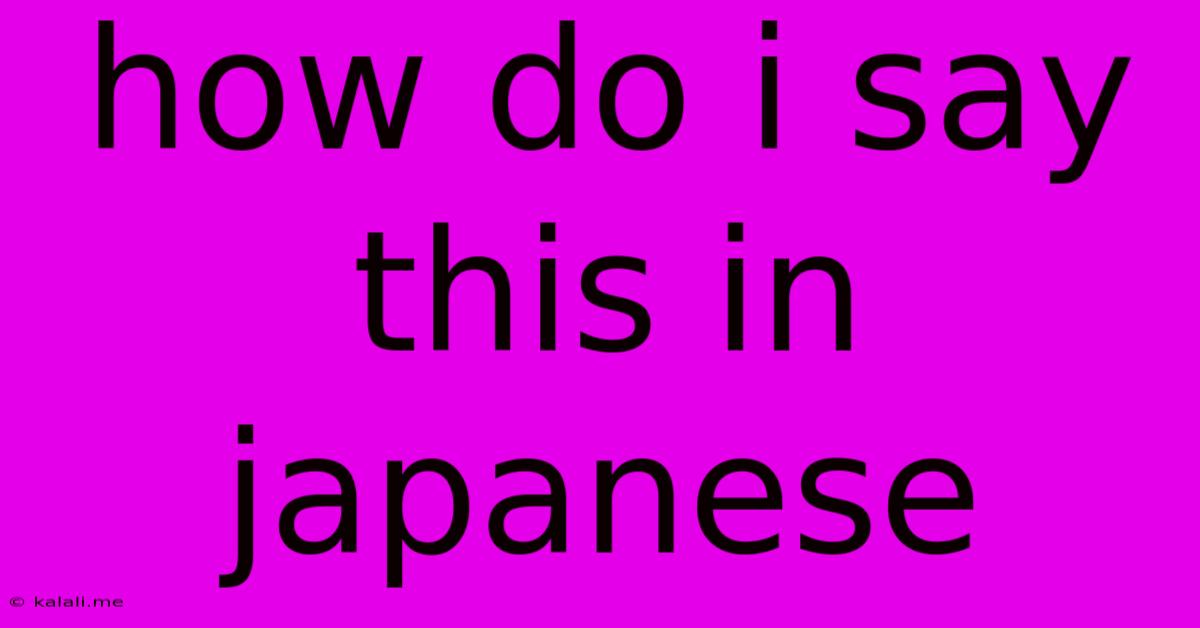How Do I Say This In Japanese
Kalali
Jun 08, 2025 · 3 min read

Table of Contents
How Do I Say This in Japanese? A Comprehensive Guide to Japanese Phrase Construction
Want to learn how to say something specific in Japanese? This guide will walk you through the process, covering everything from basic sentence structure to helpful resources for expanding your vocabulary. Learning Japanese can seem daunting, but with a structured approach, you'll be saying "こんにちは" (konnichiwa - hello) and much more in no time!
This article will cover several aspects of translating phrases into Japanese, helping you understand the nuances of the language and avoid common mistakes. We'll tackle sentence structure, verb conjugation, and particle usage, equipping you with the knowledge to confidently translate your own phrases.
Understanding Basic Japanese Sentence Structure
Unlike English, Japanese sentence structure typically follows a Subject-Object-Verb (SOV) order. This means the subject of the sentence comes first, followed by the object, and finally, the verb. For example:
- English: I eat rice.
- Japanese: 私はご飯を食べます (Watashi wa gohan o tabemasu)
Let's break it down:
- 私 (watashi): I (subject)
- は (wa): topic marker particle
- ご飯 (gohan): rice (object)
- を (o): direct object marker particle
- 食べます (tabemasu): eat (verb)
Mastering Verb Conjugation
Japanese verbs conjugate based on tense, politeness level, and mood. This is crucial for correct sentence construction. For instance, the verb "to eat" (食べる - taberu) changes depending on the context:
- 食べます (tabemasu): I eat (polite, present tense)
- 食べた (tabeta): I ate (plain, past tense)
- 食べました (tabemashita): I ate (polite, past tense)
The Importance of Particles
Particles are small words that indicate the grammatical function of words in a sentence. They are essential for understanding the meaning. We've already seen two:
- は (wa): Topic marker – indicates the topic of the sentence.
- を (o): Direct object marker – indicates the direct object of the verb.
Other important particles include:
- が (ga): Subject marker – marks the grammatical subject.
- に (ni): Indicates location, time, or indirect object.
- へ (e): Indicates direction.
- で (de): Indicates location of an action.
- と (to): Indicates accompaniment.
- から (kara): Indicates starting point.
- まで (made): Indicates endpoint.
Using Online Resources and Dictionaries
Several excellent online resources can aid your translation efforts:
- Google Translate: While not always perfect, it's a good starting point for quick translations. Remember to double-check the accuracy.
- Japanese-English Dictionaries: These provide detailed definitions and example sentences, helping you understand the nuances of words and phrases. Consider using dictionaries with audio pronunciations.
- Specialized Japanese Learning Websites and Apps: Many websites and apps offer interactive lessons and vocabulary builders.
Tips for Effective Phrase Translation
- Break down complex sentences: Divide long sentences into smaller, more manageable phrases.
- Focus on the core meaning: Don't worry about perfect grammar initially; concentrate on conveying the main idea.
- Use context clues: Pay attention to the context of your phrase to choose the most appropriate words and sentence structure.
- Practice regularly: The more you practice, the more comfortable you'll become with translating phrases into Japanese.
Learning to say anything in Japanese is a journey, but with consistent effort and the right resources, you'll be expressing yourself fluently in no time. Remember to start small, focus on building a strong foundation, and enjoy the process of learning this rich and fascinating language!
Latest Posts
Latest Posts
-
Apple Sauce Measurement In Substitute To Sugar
Jun 08, 2025
-
I Need An Impact Drive Head
Jun 08, 2025
-
Are Find The Value And Solve For X The Same
Jun 08, 2025
-
Do Women In India Wear Head Coverings
Jun 08, 2025
-
Open The Current Folder In Terminal In Nnn
Jun 08, 2025
Related Post
Thank you for visiting our website which covers about How Do I Say This In Japanese . We hope the information provided has been useful to you. Feel free to contact us if you have any questions or need further assistance. See you next time and don't miss to bookmark.